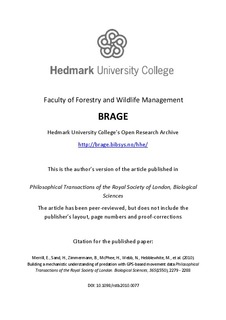Building a mechanistic understanding of predation with GPS-based movement data
Merrill, Evelyn; Sand, Håkan; Zimmermann, Barbara; McPhee, Heather; Webb, Nathan; Hebblewhite, Mark; Wabakken, Petter; Frair, Jacqueline
Journal article, Peer reviewed
Permanent lenke
http://hdl.handle.net/11250/134178Utgivelsesdato
2010Metadata
Vis full innførselSamlinger
Originalversjon
Merrill, E., Sand, H., Zimmermann, B., McPhee, H., Webb, N., Hebblewhite, M., et al. (2010). Building a mechanistic understanding of predation with GPS-based movement data Philosophical Transactions of the Royal Society of London. Biological Sciences, 365(1550), 2279 - 2288 http://dx.doi.org/10.1098/rstb.2010.0077Sammendrag
Quantifying kill rates and sources of variation in kill rates remains an important challenge in linking predators to their prey. We address current approaches to using GPS-based movement data for quantifying key predation components of large carnivores. We review approaches to identify kill sites from GPS-movement data as a means to estimate kill rates and address advantages of using GPS-based data over past approaches. Despite considerable progress, modeling the probability that a cluster of GPS points is a kill site is no substitute for field visits but can guide our field efforts. Once kill sites are identified, time spent at a kill site (handling time) and time between kills (killing time) can be determined. We show how statistical models can be used to investigate the influence of factors such as animal characteristics (e.g., age, sex, group size) and landscape features on either handling time or killing efficiency. If we know the prey densities along paths to a kill, we can quantify the “attack success” parameter in functional response models directly. Problems remain in incorporating the behavioural complexity derived from GPS movement paths into functional response models, particularly in multi-prey systems, but we believe that exploring the details of GPS-movement data has put us on the right path.
Beskrivelse
Artikkelen er en postprint av artikkelen utgitt i Philosophical Transactions of the Royal Society of London, Biological Sciences. Den publiserte versjonen av artikkelen kan du finne her: http://rstb.royalsocietypublishing.org/content/365/1550/2279.abstract
